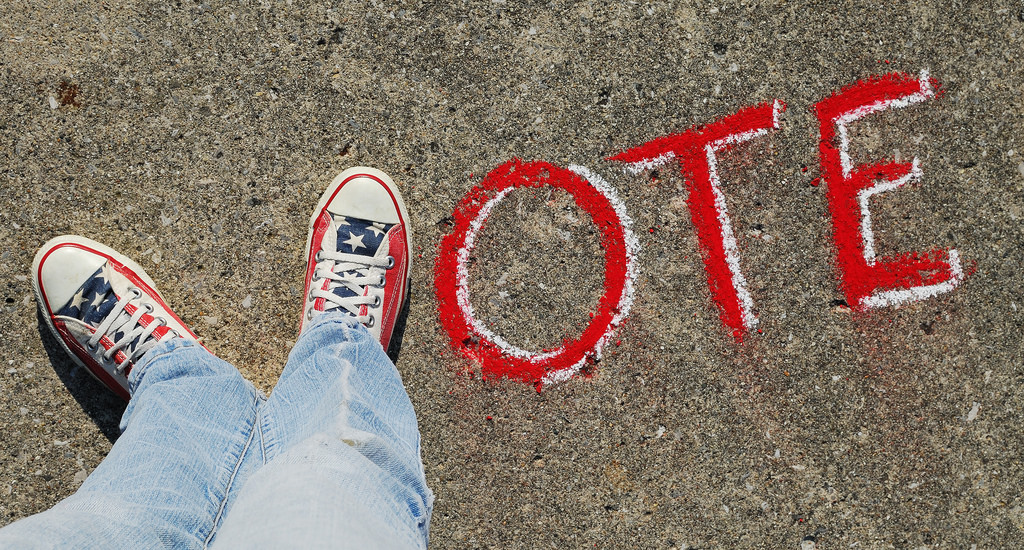Author’s Note:
As a teenager, I was one of those political junkies who read the newspaper daily in my high school library, surrounded by a small knot of likeminded peers. So yeah, not the coolest, but definitely the most informed. I would have given anything to be able to vote at 16, especially since I’d been paying taxes since age 12 (through a job delivering newspapers, then working in a local restaurant). Unfortunately for my teenage self, passionate, action-oriented organizations like Vote16USA didn’t exist in the 1990s. No one in my small California town would have given more than an eye roll to the idea of 16 year olds casting a ballot. Fortunately for youth today, the issue of lowering the voting age in local elections is gaining the attention it deserves. As an educator, I was thrilled to write this lesson plan on an issue so close to my heart (going on decades now…). The plan is meant to give an overview of the issue and spur debate. Some young people are eager to vote; others may not feel ready. Regardless of where you stand on this issue, it’s important to talk about what it means to participate in a democracy—and what it means to be a taxpayer and rely on public services without having a voice in helping shape policy, especially at the local level.
Featured resources
- KQED’s The Lowdown blog post and video: Should San Francisco Lower Its Voting Age?
- Forbes: No, We Shouldn’t Lower the Voting Age to 16
Lesson Objectives
- Students will evaluate the arguments for and against teenagers ages 16 and 17 being allowed to vote in local elections and reflect on their own views of the issue.
- Students will respond both in writing and orally to argue their own position and counter opposing arguments.
Lesson Rationale
Youth civic action and participation has arguably never been more relevant. Recent environmental and civil rights protests have put the voices of young people front and center. Yet while these youth activists can post on social media, join protest marches, and even sue the federal government, they cannot cast a ballot until they turn 18. Efforts to lower the voting age to 16 are gaining traction, but are still largely unknown. The purpose of this lesson plan is to get students thinking and talking about whether or not they and their peers are ready to vote and what it could mean if they do, both now and in the future.
Common Core Standards
CCSS.ELA-Literacy.CCRA.R.1: Read closely to determine what the text says explicitly and to make logical inferences from it; cite specific textual evidence when writing or speaking to support conclusions drawn from the text.
CCSS.ELA-Literacy.CCRA.R.7: Integrate and evaluate content presented in diverse media and formats, including visually and quantitatively, as well as in words.
CCSS.ELA-Literacy.W1: Write arguments to support claims with clear reasons and relevant evidence
Key Vocabulary
| Word | Simple definition |
| To canvass (v.) | To speak or interact directly with people regarding their vote on a specific issue or for a political candidate |
| Disenfranchised (adj.) | Not able to vote |
| Inclusive (adj.) | Including all services, participants or items that are required |
| Municipality (n.) | A city or town that has a local government |
| Ordinance (n.) | A law or piece of legislation |
Essential Questions and Lesson Context
What are the best strategies for getting teens under 18 involved in political issues that affect their lives? What are the reasons for and against lowering the voting age?
Several countries, including Brazil and Great Britain, and two towns in Maryland have lowered the voting age to 16 or 15 for local elections. Arguments in favor of lowering the voting age point out that teens deserve a voice since they often work, pay taxes and rely heavily on local services, like public transportation and education. Research also shows that when teens vote earlier they are more likely to vote as adults, thus boosting voter turnout nationally. Counter arguments claim that 16 and 17 year olds are not mature enough to vote, as demonstrated by other laws that view those under 18 as minors. San Francisco voters didn’t pass Proposition F in November 2016, which would have made San Francisco the first major city to lower the voting age. However, efforts to lower the voting age continue throughout California and the nation.
Lesson Opening: Quick Write
Do you think 16 year olds should be allowed to vote in local elections? Why or why not? If it were legal, would you choose to vote at age 16? Explain your answer.
A quick write allows students to write down their thoughts before discussing the opening question in order to increase participation and make the discussion more accessible to English Language Learners.
Guided and Independent Practice
- Discuss the quick-write prompt. Do students think 16 year olds should be allowed to vote?
- As a class, watch the video featured in The Lowdown post, “Should San Francisco Lower Its Voting Age.” After the video, let students know that Proposition F didn’t pass, but several cities around the world have lowered the voting age to 16. The issue isn’t dead, as the following readings will show.
- In small groups or individually, students read the text of The Lowdown post and the Forbes article, then make a list of the arguments in favor and against the issue.
Model making the pro/con list if needed by starting the list after watching the video. Then have students break into small groups to read the suggested articles, which offer further arguments. - After students have made the pro/con list, ask them to choose any argument they personally disagree with and make a case for their own viewpoint in writing. They should prepare their argument in a way that can be shared with the class, either orally, on paper, or in an online document.
Model the written response, if needed. A response could look like: I disagree with ____________(name of person or writer who made the argument) when s/he said, “___________” (direct quote from article). Instead, I believe ___________(what the student believes) because _____________ (student supports argument with evidence.) - Have students share their responses with the class or in their small groups.
Discuss the following questions or ask students to complete them in writing as part of a lesson reflection or exit ticket.
- One of the arguments against lowering the voting age is that 16 year olds aren’t mature enough to vote. If you disagree, what could teens do to prove to their local election commission that they are responsible enough to vote?
- One of the reasons in favor of lowering the voting age is that it may encourage people to continue to vote as adults. Do you think this would be true for you if you could vote at 16?
- Do you think lowering the voting age is the best way to get teens more involved in civic issues? If so, why? If not, what might be a better way to get teens involved?
Extension/Homework Options
- Don’t hate, annotate: Students comment on each other’s written arguments on lowering the voting age and can respond directly to the featured articles online using an annotation platform like Hypothes.is. Visit these sites for a quick teacher tutorial and further resources.
- Write/speak locally: Students turn their pro or con arguments into a letter, short speech or presentation, then research ways to make their voices heard in their community. (Example: Speaking during the public comment section of a city council meeting, posting on an online forum, etc.).
Author’s Concluding Note
Regardless of their stance on lowering the youth voting age, young people can make their voices heard in many ways beyond the ballot box. Encouraging active civic participation is not a partisan issue. It is necessary for a democracy to flourish. All of our voices matter—and the earlier young people come to see themselves as active and engaged, the healthier our democracy will be. The debate surrounding the youth voting age reminds us of this. Whether your students are reading the newspaper every day as I did, protesting policies they disagree with, writing letters, speaking to elected officials or simply trying to figure things out, helping them make their voices heard will always make a difference.
About the Author
 Rachel Roberson is KQED’s news education manager. Previously, she was a writing and humanities teacher leader on three continents, having served on the founding staff of KIPP Bayview Academy in San Francisco before moving to schools in Abu Dhabi and Austin, Texas. She started her teaching career as a Peace Corps volunteer in Cameroon. After 11 years in the classroom, Rachel worked in Oakland public schools as a senior program manager for Reading Partners and later as a trainer and staff development consultant for nonprofits, schools and women-owned businesses. A graduate of Northwestern University, Rachel was a journalist in the Bay Area before becoming an educator.
Rachel Roberson is KQED’s news education manager. Previously, she was a writing and humanities teacher leader on three continents, having served on the founding staff of KIPP Bayview Academy in San Francisco before moving to schools in Abu Dhabi and Austin, Texas. She started her teaching career as a Peace Corps volunteer in Cameroon. After 11 years in the classroom, Rachel worked in Oakland public schools as a senior program manager for Reading Partners and later as a trainer and staff development consultant for nonprofits, schools and women-owned businesses. A graduate of Northwestern University, Rachel was a journalist in the Bay Area before becoming an educator.

